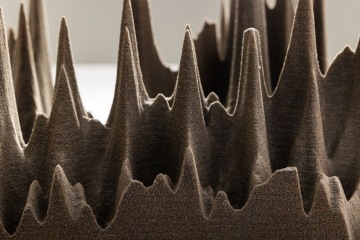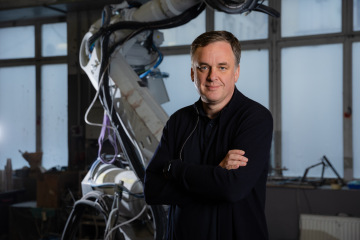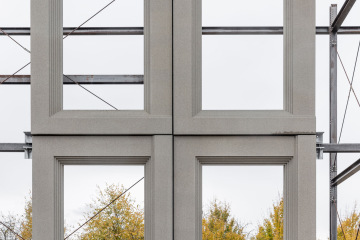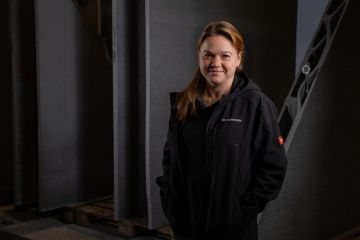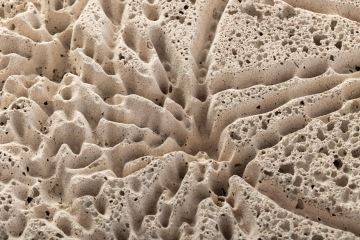
While glossy surfaces may still be popular in certain contexts, architects and designers today have an increasing number of opportunities to explore how the possibilities of rough surfaces can be exploited to create new, more sophisticated forms of “Digital Raw” that reflect contemporary values and aspirations.
Share article
"Digital Raw" surfaces are characterized by their rough, raw aesthetics, which reflect the authentic and inherent qualities of known materials. The utilization of these properties in architecture offers a wealth of opportunities for experimentation with materials and techniques, while at the same time all key aspects of the methods and processes involved meet sustainability requirements.
Rough, raw materials and untreated surfaces of building elements can be very useful in the effort to achieve better energy efficiency in buildings and spaces, with one of the defining principles of the “Digital Raw” technology being the use of local and recyclable materials, aiming to create healthier spaces for living.
The "Digital Raw" concept is not only about specific aesthetics, but primarily represents ways of expressing values and principles that are becoming increasingly important in architecture and design. The emphasis on this approach is particularly relevant today, as issues of sustainability, ecology and social responsibility are gaining more attention in society.
The "Digital Raw" style is currently perceived as luxurious because it is a completely new phenomenon, filling the abstract space between raw authenticity and the sophisticated elegance often associated with glossiness.
It can successfully emerge as a new architectural style that shifts the traditional notion of luxury towards authenticity, "material honesty" and aesthetic depth. It could serve as a starting point for a new definition of luxury – one in which the move away from glossy
surfaces, long regarded as its symbol, will lead to a greater appreciation of the aesthetics of rough, untreated and textured surfaces, while also signalling a fundamental shift in values and preferences in design and architecture.
I. Authenticity and Uniqueness:
Rough, unprocessed materials and surfaces produce a sense of authenticity and uniqueness, which is highly valued nowadays. In an era of mass production and uniformity, unique and original elements offer a new level of luxury.
II. Material Integrity:
The aesthetics of rough surfaces celebrate and highlight the beauty and integrity of materials in their purest and rawest form. These principles stem from the ability to appreciate natural materials and their inherent qualities.
III. Tactile Experience:
Rough surfaces offer a variety of tactile sensations, contributing to a more complex perception of space. Luxury thus becomes not only a visual but also a tactile experience.
IV. Sustainability and Ecology:
Embracing rough, raw materials can also be seen as an acceptance of a commitment to sustainability and a focus on ecological values, which are becoming increasingly important in the luxury sector.
V. Aesthetic and Emotional Depth:
Roughly finished surfaces add aesthetic and emotional depth to a space, allowing for the creation of distinctive environments that evoke strong emotional responses.
VI. Departure from the Traditional Perception of Luxury:
There is a growing trend today towards rejecting traditional symbols of luxury in favour of simpler, “purer" forms of lifestyle and design. This perception of luxury emphasizes quality of life and personal expression.
VII. The Use of Robotic Fabrication Technology:
3D concrete printing (3DCP), augmented reality (AR) and materials such as textiles, concrete, glass, foam concrete and geopolymers in “Digital Raw" related processes requires a multidisciplinary approach. This approach allows for the creation of innovative architectural forms while taking advantage of all available technologies and materials.
While glossy surfaces may still be popular in certain contexts, architects and designers today have an increasing number of opportunities to explore how the possibilities of rough surfaces can be exploited to create new, more sophisticated forms of “Digital Raw” that reflect contemporary values and aspirations.
Share article
More news
Pavel Grečner, Technical Director of So Concrete
“Let’s think ahead.” This quote from one of our presidents perfectly captures the mindset of Pavel Grečner, Technical Director at So Concrete.
Impact test of facade elements for the OLOE office building
The OLOE office building, which is part of the southern part of Prague's vast new Smíchov City district, will receive a facade, the first segments of which are currently being tested as part of the so-called impact test.
Marie Kovářová, CEO of So Concrete
"Everything is possible when there’s a will. And a good team can achieve much more than any individual," says Marie Kovářová, the new CEO of So Concrete.
